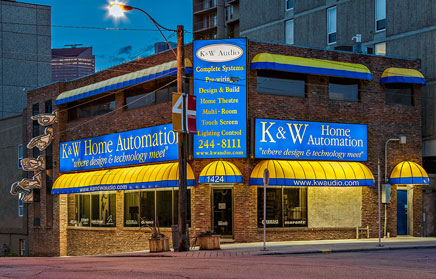Hang Your Flat Panel TV On the Wall!
Five Tips for the Best Installation
Aside from great image quality and great looks, another aspect that draws people to flat panel digital television displays is their ability to go anywhere. Shallow depth cabinets, and tons of mounting options, allow you to place your new flat panel TV where no TV has gone before! You can do it yourself, or if it seems daunting, we have great installers just waiting to help. But before you or one of our professional installers start drilling holes; take a look at these five important considerations.
1. Location
Sure, that 50-inch LED will look awesome mounted over the fireplace mantle, but will you be able to see it from the couch without straining or craning your neck? Finding the right spot for your flat panel (good height and the proper viewing distance) is a balance between aesthetics and practicality. For optimum viewing, the center of the screen should be right about eye level from the primary viewing position. So in your family room, for instance, you will want the center of the screen at eye level as you sit on your favorite spot on the sofa. If this doesn’t quite fit your room design, try positioning the bottom of the screen at eye level. This only requires you to look up slightly as you sit on the sofa, and it may actually provide additional visibility from a nearby room.
2. Power
Many of today’s flat panel displays can be the centerpiece of a room’s décor even if never turned on. But since you will be using it for it’s intended purpose too, you’re going to have to plug it in to power. The question is, where? Unless you’re lucky enough to have an electrical outlet behind the TV’s mounting location, you need to decide how you’ll power your set. One popular, low-cost option is cable management “racetracks.” These paint-able, thin plastic strips attach directly to your wall to conceal any number of power and signal cables. A major benefit of these systems is the ability to easily run new cables as you add or swap out components. However, for the cleanest, custom-installed look, you will want a power outlet and A/V connections “hardwired” directly behind your set. Conduit in the wall gives all the benefits of an on wall racetrack and the best in hidden design too. And don’t forget about protection. Standard surge protectors or power strips are typically too large for such installations, so consider specially designed “flat panel TV” surge protectors, slim enough to squeeze behind your wall-mounted digital television.
3. Connectivity
New sources become available all the time. Servers, Games and digital media devices all need to be hooked up to the TV. Having quick and easy access to the set’s inputs is very important. If you mount the TV above the fireplace, will you be able to quickly, easily and safely plug-and-play these types of devices when you want to? Work with us to plan how you will add additional source components or plug-and-play portable devices as you wish. That’s after all why we are here! For maximum connectivity and ease of use, consider using an A/V receiver to do the job of switching between sources. In this setup, all of your sources (cable box, DVD player, game console, digital camera, etc.) connect to the A/V receiver and a single HDMI cable output runs to the TV. Aside from providing good quality audio and surround sound decoding (you’ll need speakers too of course!), this setup is preferred because it lets you leave the TV on one input and use the A/V receiver to select which source you will watch. It sure beats flipping through the inputs on the TV.
4. Mounts
Wall mounts come in all sorts of shapes, sizes and capacities. Choosing the right mount can be fun though. Generally your TV and the mount will comply with the VESA-standard mounting holes. Almost all flat panel displays do. So when you choose a style, the VESA designation for both the set and mount must be the same to ensure they work with each other. You may want a mount that offers the ability for some vertical tilt, particularly if you’re mounting it a higher than eye level. This can also help fine-tune the viewing angle and minimize glare from windows or lights. Alternatively, you may want a “low profile” mount to keep the shallow depth panel as close to the wall as possible for a clean look. For a bedroom or master bathroom, you’ll probably want a swiveling or cantilever mount that will allow you to turn, swing and position the TV in multiple positions depending on where you are in the room. For kitchens, under-cabinet mounts can let the screen fold up out of sight when you’re not using it. Obviously, choose a mount that can support the size and weight of your set.
5. Sound
Great audio is a key part of the home A/V experience, yet audio is often an afterthought. If you’re going to tune into HDTV broadcasts, immerse yourself in a DVD movie or go to battle in one of your favorite video games, you absolutely need to think about audio. Don’t miss out on these formats’ high-fidelity surround sound by using your TV’s built-in speakers. So what does this have to do with where and how you mount your flat panel TV? Consider what connections and space you will need to include surround sound now or in the future. For example, have you left room on either side and above or below the screen for speakers? Have you got a Soundbar in mind? If so wil it mount to the wall, our hang under the TV?
When answering any of the questions raised in this exploration is a bit difficult, you know we are just a phone call or email away – don’t be afraid to use us as your resource!


